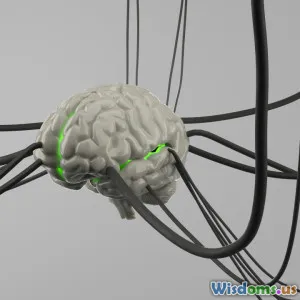
The Neural Basis of Happiness Explained
32 min read A concise guide to how brain circuits and neurotransmitters generate happiness, with research-backed examples and practical levers—sleep, exercise, sunlight, and mindfulness—for lasting well-being. (0 Reviews)
Happiness does not float above the brain like a vague cloud of good vibes. It is engineered moment by moment by cells, circuits, and chemicals predicting what matters, allocating energy, and stitching meaning into experience. The neural basis of happiness is not one switch or one molecule, but a choreography: reward signals that teach, mood systems that stabilize, networks that reframe, and bodily inputs that whisper yes or no to safety. Understanding this choreography does not cheapen joy; it gives us leverage. When you map the mechanisms, you can tweak the dials.
What follows is a clear, science-grounded tour of the brain’s happiness machinery, paired with practical steps you can try. Your goal is not to become a lab experiment, but to become a kinder architect of your own mind.
What neuroscientists mean by happiness

Happiness is not one thing. Neuroscientists usually distinguish at least three flavors:
- Hedonic well-being: positive feelings like pleasure, comfort, and excitement. Think of warmth after stepping indoors on a cold day.
- Eudaimonic well-being: a deeper sense of meaning, fulfillment, and alignment with values. Picture the quiet satisfaction after mentoring a student or finishing a community project.
- Engagement or flow: absorbed focus where self-talk fades and time distorts, such as when a musician gets lost in a performance.
Different methods measure different pieces. Surveys capture life satisfaction and positive affect. Lab tasks probe learning from rewards, reaction to novelty, or resilience to stress. Brain imaging shows networks like the default mode network (DMN), salience network, and executive control network shifting activity based on context. Physiological signals such as heart rate variability (HRV) reflect bodily calm and flexibility.
Why this matters: if you chase only immediate pleasure, you train short-term reward circuits but neglect the slower, stabilizing networks that support purpose. Conversely, meaning-rich lives can stagnate without occasional joy or novelty. Balanced happiness draws on short-term rewards, longer-term values, and engaged focus.
Example: finishing a difficult run offers both hedonic bliss (endorphins and endocannabinoids) and eudaimonic pride (prefrontal integration of effort with identity). It also gives flow if you paced the challenge just right.
The core reward circuit: dopamine’s teaching signal

Dopamine is not pleasure juice; it is a teaching signal about what is better than expected. Midbrain neurons in the ventral tegmental area (VTA) project to hubs like the nucleus accumbens and prefrontal cortex. When outcomes exceed predictions, dopamine pulses; when outcomes are worse, firing dips. Over time, cues that predict reward begin to trigger dopamine, not the reward itself.
- Prediction error: the gap between what you expected and what happened. Slot machines are engineered to exploit this with variable, unpredictable rewards.
- Shaping behavior: when you get unexpected praise for helping a colleague, dopamine helps tag the context, people, and actions that led to that surprise. You’re more likely to repeat helpful behavior.
- Motivation over pleasure: dopamine focuses attention, energizes action, and facilitates learning. Pleasure also involves opioids and other systems.
What to do with this knowledge:
- Create healthy surprise. Rotate your workout routes or playlists. Novelty amplifies dopamine’s teaching without requiring bigger rewards.
- Use small, frequent feedback. Break big goals into steps, each with immediate signal of progress. Examples: a daily progress bar for writing 300 words; a weekly chart for saved dollars.
- Beware of infinite scroll. Apps use intermittent rewards to hijack prediction error. Reclaim it by batching notifications or scheduling scroll windows.
Serotonin, mood tone, and safety signals

Serotonin, released widely from the raphe nuclei, modulates mood tone, patience, and the sense that the present is safe enough to pause. Instead of teaching what is new, it often supports what is stable: behavioral inhibition when waiting is wise, reduced reactivity to hassles, and the capacity to value longer-term outcomes.
Key points:
- Receptors matter. 5-HT1A actions relate to calm and mood stabilization; 5-HT2A receptors are engaged by psychedelics, transiently increasing cognitive flexibility and promoting new associations under supportive conditions.
- Clinical leverage. Selective serotonin reuptake inhibitors (SSRIs) increase synaptic serotonin over weeks, often improving mood stability. They do not create euphoria; they soften the sharp edges of negative affect for many people.
- Patience and persistence. In tasks where waiting yields better rewards, higher serotonin tone is associated with patience. Think of a baker waiting for dough to rise rather than cranking the oven and burning the loaf.
Actionable steps:
- Build micro-pauses into the day: three times daily, inhale slowly for four, exhale for six, for two minutes. This interoceptive practice engages vagal pathways that interplay with serotonin’s calming signals.
- Nourish tryptophan availability by pairing protein with complex carbs in meals, supporting serotonin synthesis. Examples: oats with yogurt; lentil soup with whole-grain bread.
Oxytocin, opioids, and the chemistry of connection

Human happiness is social at its root. Oxytocin supports trust and bonding; endogenous opioids contribute to the warm pleasure of social touch and laughter. Physical contact like hugging releases a neurochemical ensemble that reduces pain perception and stress responses.
Examples grounded in research:
- Laughter in groups increases beta-endorphins, improving pain tolerance and feelings of closeness. Try a weekly comedy night with friends; the shared mirth matters.
- Choir singing synchronizes breathing and heart rhythms and elevates bonding hormones, boosting mood and connection.
- Gentle, sustained touch at slow stroking speeds activates C-tactile fibers, which project to insula and orbitofrontal cortex, producing soothing affect.
Tips for practice:
- Initiate prosocial micro-moments: greet neighbors, make eye contact with the barista, leave a sincere note of appreciation for a teammate. Small signals of safety and regard accumulate.
- If touch is not comfortable or culturally appropriate, synchronize in other ways: shared walking pace, coordinated cooking, or singing along to the same rhythm.
The prefrontal cortex: curator of experience

The prefrontal cortex (PFC) does more than plan. It curates meaning. The ventromedial PFC (vmPFC) computes subjective value, integrating emotion and memory; the dorsolateral PFC (dlPFC) supports working memory and cognitive control; the anterior cingulate cortex (ACC) monitors conflict and effort costs.
This curation makes happiness trainable. Cognitive reappraisal, a core skill in therapies like CBT, uses PFC circuits to reinterpret events and reduce amygdala reactivity.
Example:
- A setback like a rejected proposal can be framed as a referendum on your worth or as a data point shaping the next iteration. The vmPFC tags the latter frame with different value, reducing negative affect and preserving motivation.
How-to reappraise in 90 seconds:
- Name the trigger and the body signal it evokes (tight chest, hot face). Labeling recruits PFC and softens amygdala activity.
- Generate two alternative explanations that are specific and testable. Example: timing was bad; the use case needs clearer metrics.
- Choose one action you can take within 24 hours. Action converts uncertainty into agency, which the ACC registers as reduced conflict.
The body’s barometer: interoception, vagus nerve, and calm

Happiness depends on whether the brain forecasts the body as safe and resourced. Interoception is the brain’s read of internal signals like heartbeats, gut stretch, and breath. The insula maps these sensations; the vagus nerve carries parasympathetic signals that slow heart rate and support calm.
Heart rate variability (HRV), the beat-to-beat variation in heart rhythm, is a useful marker: higher resting HRV generally reflects better flexibility in shifting between mobilization and recovery. People with higher HRV often report more positive emotions and resilient stress responses.
Practical ways to engage this system:
- Extended exhale breathing: inhale 4 seconds, exhale 6–8 seconds, for 5 minutes. The longer exhale activates vagal pathways and can reduce sympathetic drive.
- Physiological sighs: two short nasal inhales followed by a long exhale, repeated 1–3 times, rapidly downshift arousal.
- Cold face immersion or a cool splash can trigger the diving reflex, briefly boosting parasympathetic tone.
These are not hacks; they are direct ways of signaling to the brain that the internal milieu is stable, enabling networks that support curiosity and savoring.
Stress, cortisol, and why chronic pressure dulls joy

Short bursts of stress sharpen the mind, but chronic stress dims it. The hypothalamic-pituitary-adrenal (HPA) axis controls cortisol release. Acute spikes mobilize glucose and sharpen attention. Chronic elevation, however, can shrink dendrites in the hippocampus, bias attention toward threats, and disturb sleep.
Signs your joy circuits are dulled by stress:
- You no longer enjoy once-pleasurable activities (anhedonia), even though you remember that you should.
- Your patience vanishes; small hassles trigger outsized reactions.
- Sleep is shallow or fragmented, increasing next-day amygdala reactivity by 30–60% in lab studies.
What helps:
- Morning light exposure for 10–20 minutes anchors circadian rhythm, improving cortisol timing and sleep quality.
- Boundary rituals: a 10-minute daily transition walk without phone between work and home. The brain learns context shifts; the ACC marks the end of effort.
- Stress inoculation: train with manageable challenges (cold showers, tough workouts, speaking up once per meeting) to build confidence that stress is tolerable and transient.
Plasticity: how habits reshape happy circuits

Neurons that fire together wire together. Plasticity depends on repetition, attention, and neurochemical context. Brain-derived neurotrophic factor (BDNF) supports synaptic growth, and it increases with exercise, deep sleep, and effortful learning.
Leveraging plasticity:
- Repetition with variation: learn guitar chords by rotating keys and rhythms, not just drilling one pattern. Variation protects against boredom and overfitting.
- Effort tagging: immediately celebrate small wins to release dopamine and mark the circuit for consolidation. Even a physical gesture like a fist pump can help.
- Sleep to lock it in: stage NREM consolidates facts and skills; REM integrates emotions with memories. Protect both by regular sleep and a wind-down routine.
A habit loop strategy:
- Cue: a stable trigger (after morning coffee).
- Action: 10 minutes of gratitude journaling or mobility work.
- Reward: track the streak visually; share with a friend weekly.
Within weeks, circuits supporting attention and positive affect become more efficient, making the practice feel natural rather than forced.
Biases of the brain: hedonic treadmill and prediction

The hedonic treadmill is real: the brain adapts to stable stimuli. Neurons reduce firing to repeated inputs; prediction errors shrink as the new becomes the normal. Happiness dips not because life worsens, but because surprises fade.
Evidence across life events shows adaptation curves: after raises, people revert toward baseline well-being within months; after injuries, many recover more happiness than expected. The brain is a comparator; relative change often matters more than absolute level.
How to counter adaptation:
- Savoring: deliberately slow down to notice sensory detail during a positive moment. Try the 20-second savor: hold a warm mug, note aroma, temperature, and gratitude before sipping.
- Strategic novelty: rotate contexts without expensive changes. Work from a new cafe once weekly, or switch the route of your evening walk.
- Reset expectations thoughtfully: approach goals as experiments. If a result falls short, update the model rather than the self-worth score.
Flow states and the quieting of self

Flow emerges when challenge meets skill with clear goals and immediate feedback. Brain imaging shows decreased activity in parts of the default mode network associated with self-referential chatter, and coordinated activity in attention and motor networks.
Design for flow:
- Clear goals: define what success for this session means (write 500 words that advance argument X).
- Immediate feedback: choose tasks where you can see progress, like sketching wireframes or iterating code tests.
- Adjustable difficulty: aim for 4% above your current skill. Too easy, and boredom; too hard, and anxiety.
- Timeboxing: 45–90 minute blocks exploit natural ultradian rhythms.
Examples: a rock climber scanning a route, a surgeon in a well-practiced procedure, a game designer balancing mechanics. In each case, attention is fully engaged, the sense of self softens, and reward shifts from outcome to process.
Food, gut microbes, and mood

The gut-brain axis is not hype. Gut microbes produce metabolites like short-chain fatty acids that modulate inflammation and potentially influence mood. Tryptophan, an amino acid precursor to serotonin, competes for transport across the blood-brain barrier; diet composition and inflammation influence its fate.
Evidence to note:
- Mediterranean-style diets rich in vegetables, legumes, whole grains, nuts, fish, and olive oil are associated with lower depression risk. In a randomized trial of dietary support for depression, participants who shifted toward such a pattern improved mood more than controls receiving social support alone.
- Fermented foods like yogurt, kefir, kimchi, and sauerkraut can increase microbiome diversity; some studies link higher diversity with better emotional regulation.
Practical plate:
- Breakfast: oats with berries, yogurt, and walnuts.
- Lunch: lentil salad with olive oil, lemon, leafy greens, and sardines or chickpeas.
- Dinner: roasted vegetables, quinoa, and salmon or tofu; side of kimchi.
- Snacks: fruit, dark chocolate, or a handful of almonds.
Sleep and light: the daily reset of affect

Sleep is emotional first aid. One night of poor sleep heightens amygdala reactivity and reduces prefrontal regulatory control the next day. REM sleep appears to decouple emotional charge from memories; NREM supports memory consolidation and physical recovery.
Circadian anchors:
- Morning light within an hour of waking stabilizes the clock; even on cloudy days, outdoor light can be 10 times indoor levels.
- Consistent sleep and wake times improve sleep quality more than any supplement.
- Dim lights and screens 90 minutes before bed to allow melatonin rise.
Wind-down routine example (20–30 minutes):
- List tomorrow’s top three tasks to off-load working memory.
- Gentle mobility or stretching to signal physical safety.
- Read fiction or non-demanding nonfiction in print; avoid heated debates or news.
Movement as medicine: exercise, play, and joy

Exercise releases a cocktail of neurochemistry: endocannabinoids that produce the runner’s high, endorphins that modulate pain, and BDNF that supports plasticity. Movement also reduces inflammatory markers that sap mood.
Guidelines with flexibility:
- Aerobic: 150 minutes per week moderate or 75 minutes vigorous. Even 10-minute brisk walks shift affect and sharpen executive function.
- Strength: two sessions weekly improve mood through mastery and metabolic health.
- Play: dance, frisbee, or pickup basketball add social reward and novelty.
Example routine: 3 days of 30-minute brisk walks or cycling; 2 days of 20–30 minutes of bodyweight strength; one playful activity on the weekend. Stack with music you love to harness reward prediction and reinforce habit loops.
Relationships are neural infrastructure

Humans regulate each other’s nervous systems. Social baseline theory suggests that the brain treats trusted others as part of its resource pool, lowering perceived costs of challenges. Loneliness, by contrast, increases vigilance and reduces sleep quality, both corrosive to happiness.
Connection upgrades:
- Active-constructive responding: when someone shares good news, respond enthusiastically and ask for details (Who was there? How did it feel?). This amplifies reward circuitry and cements bonds.
- Listening hygiene: mirror back what you heard and the feeling behind it. This recruits empathy networks and reduces misinterpretations.
- Shared rituals: weekly meals, Friday walks, or monthly potlucks provide predictable social reward and reduce the friction of planning.
If your network is thin, start with weak ties: greet and learn names at local shops, join a meetup on a topic you enjoy, or volunteer. Weak ties often blossom into strong ones over time.
Technology, myths, and modern dopamine talk

You do not need a dopamine detox; your brain is always producing and clearing dopamine. But you can design your digital environment to align with your goals.
Evidence-guided tips:
- Batch notifications. Turn off badges and set two windows per day to check messages. This restores prediction error to meaningful work rather than to random pings.
- Home screen hygiene. Put apps you want to use on your first page (reading, notes) and bury slot-machine apps in folders.
- Replace, don’t just remove. Swap an hour of doomscrolling with a structured task that includes visible progress, like learning chords or a language lesson.
A mindful take: technology is a tool for reward shaping. Use it to schedule, track, and celebrate behaviors you value, not to fill every idle moment. Leave at least 15 minutes daily of boredom; creativity often blooms in the quiet gap.
Evidence-based practices that boost happiness

Below are practices with plausible neural rationales and practical steps. Try one or two at a time.
- Gratitude journaling: 3 times per week, write about one specific person or act you appreciate and why. This trains vmPFC valuation and hippocampal recall of positive context. Share one entry weekly to recruit social reward.
- Loving-kindness meditation: 10 minutes sending goodwill to self, a loved one, a neutral person, and a challenging person. Reduces amygdala reactivity and increases positive affect.
- Awe walks: once weekly, take a 20–30 minute walk seeking vastness (clouds, architecture, nature). Awe reduces self-focused DMN chatter and increases connectedness.
- Behavioral activation: schedule one mastery activity (learn, build) and one pleasure activity (listen, savor) per week. This counters anhedonia by reengaging reward circuits through action.
- Music dosing: create a playlist that ramps from calm to energizing. Use it pre-task to shift state; music entrains rhythms and recruits reward pathways.
- Time affluence audit: remove one 30-minute low-value commitment weekly and add one 30-minute high-value connection or recovery block. This shifts chronic stress set points.
Individual differences and what to expect

People vary in baseline affect and reactivity. Genetics account for a chunk of variance in subjective well-being; polymorphisms in serotonin transport (5-HTTLPR), dopamine metabolism (COMT Val158Met), and oxytocin receptors (OXTR) can influence sensitivity to stress or reward. Early experiences sculpt systems like the HPA axis and amygdala.
The key is range, not destiny. Think of a neighborhood set point with streets you can choose. Practices shift you within your range and sometimes expand it via plasticity. Past trauma or current depression can narrow range; professional support is then an important part of the toolkit.
Personalization tips:
- Track which levers move you most: sleep, social, exercise, or contemplative practices. People differ.
- Respect neurodiversity. Some prefer predictable routines; others crave novelty. Design happiness practices to fit your nervous system, not an idealized template.
How to run your own seven-day neural tune-up

A short, structured experiment can reveal what helps you most. Here is a seven-day plan that covers major levers without overload. Keep notes on mood, energy, and social connection.
- Day 1: light and intent. Morning outdoor light for 15 minutes. Write a 1-sentence purpose for the week: what value you want to express. Evening: 10-minute wind-down routine.
- Day 2: movement and savoring. 20–30 minutes brisk walk. During one pleasant moment, practice the 20-second savor. Note sensory details.
- Day 3: social micro-upgrades. Send one appreciative message. Practice active-constructive responding at least once. Evening: 5 minutes extended exhale breathing.
- Day 4: mastery bite. Choose a skill and do a focused 25-minute session with visible progress (one guitar riff, one coding function, one sketch). Finish with a fist pump to tag the win.
- Day 5: awe and nature. Take an awe walk in a new area. No headphones. Note three things that felt vast or surprising.
- Day 6: nourish. Prepare one Mediterranean-style meal. Eat without screens, noticing taste and scent. Evening: list tomorrow’s top three tasks.
- Day 7: reflect and reframe. Review the week: which practices moved your mood and which felt forced? Write a brief reappraisal of a current stressor with two next steps.
Decide which two practices to keep for the next month. Depth beats breadth.
Measuring progress without killing the joy
What gets measured can improve, but over-measurement can drain delight. Aim for light-touch feedback that supports learning.
Options:
- Weekly check-in: rate on a 1–10 scale your mood, energy, connection, and meaning. Look for trends rather than fixating on daily noise.
- Experience sampling: three prompts per day for one week asking what you’re doing and how you feel. This reveals which activities reliably lift you.
- HRV or sleep scores: use wearables if you already have them, but focus on directionality, not perfection.
Avoid turning happiness into a productivity contest. Use data as a mirror, not a judge. When in doubt, choose practices that feel nourishing, not impressive.
The long view: meaning, values, and neural harmony

Pleasure is sweet, but meaning sustains. The vmPFC integrates value across time and contexts, aligning immediate choices with longer-term narratives. When your actions serve values you endorse, the brain’s appraisal systems tag effort as worthwhile, even when it’s hard.
Practical alignment steps:
- Name top values (for example, learning, kindness, health, creativity). For one week, schedule one behavior per value. Keep it small: 15 minutes of reading, one unsolicited kind note, a walk, a doodle.
- Craft a contribution story: write a paragraph on how your work or care helps someone real. Update it monthly. This shifts attention from self-evaluation to service, which lessens threat vigilance.
- Periodically prune. Say no to commitments that clash with values, even if they look good on paper. The brain prefers coherence; conflict taxes the ACC and drains mood.
Happiness, seen through the neural lens, is a dynamic equilibrium: a brain predicting and adjusting, body signals of safety and energy, relationships that scaffold effort, and a story that renders it all meaningful. The goal is not constant elation but increasing capacity to return to curious, connected, and purposeful states. That capacity grows with practice. Your brain is listening to what you do next.
Rate the Post
User Reviews
Popular Posts















